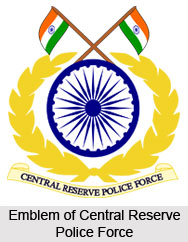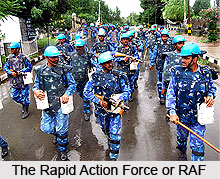 The Central Reserve Police Force, also called CRPF, is a paramilitary security agency functioning under the aegis of Ministry of Home Affairs, Government of India. The primary role of Central Reserve Police Force lies in assisting the State or Union Territories in police operations, thus maintain law and order and restrain insurgency. Central Reserve Police Force came into existence as the Crown Representative`s Police on 27 July 1939. After Indian Independence, its name was changed to Central Reserve Police Force on enactment of the CRPF Act on 28 December 1949.
The Central Reserve Police Force, also called CRPF, is a paramilitary security agency functioning under the aegis of Ministry of Home Affairs, Government of India. The primary role of Central Reserve Police Force lies in assisting the State or Union Territories in police operations, thus maintain law and order and restrain insurgency. Central Reserve Police Force came into existence as the Crown Representative`s Police on 27 July 1939. After Indian Independence, its name was changed to Central Reserve Police Force on enactment of the CRPF Act on 28 December 1949.
The Director General of Central Reserve Police Force is Mr. SIS Ahmed of 1970 IPS batch. He was appointed on 1st March 2007. Besides law, order and counter insurgency duties, the role of Central Reserve Police Force in the General Elections has been very significant and vital and was repeatedly enacted during the past few years. Central Reserve Police Force has a special eye for the states of Jammu and Kashmir, Bihar and in the North East. During the Parliamentary elections of September 1999, the Central Reserve Police Force did security arrangements at its best. The Central Reserve Police Force was declared as one of the largest paramilitary force in the world with 200 battalions besides various establishments. Of late, Central Reserve Police Force contingents are also being deployed in important UN missions.
When Central Reserve Police Force was the Crown Representative Police before independence with 2 battalions, the basic objective was to protect the British residents in sensitive states. However, during the 1960s, Central Reserve Police Force saw major expansion since many State Reserve Police Battalions were merged with CRPF. It has been active against foreign invasion and domestic insurgency.
On 21st October 1959, Central Reserve Police Force faced a crisis when the Chinese Army Deputy attacked Deputy S.P. Karam Singh and his 20 soldiers at Hot Springs in Ladakh. 10 were killed and the rest were taken prisoners. 21st October is now remembered across India as Police Commemoration Day. In the 1965 India-Pakistan war, 150 men of the 2nd Battalion of Central Reserve Police Force defeated an infantry contingent of Pakistan Army at Kanjar Kot in Gujarat. The Central Reserve Police Force guarded the India-Pakistan border until 1965; eventually the Border Security Force was created for that purpose.

On 13th December 2001, the Central Reserve Police Force troopers killed all five terrorists who had entered the grounds of the Indian Parliament at New Delhi. In 2005, the Central Reserve Police Force troops again successfully confronted the terrorists at Ram Temple of Ayodhya. In recent years, the Central Government decided to follow up on recommendations of the Cabinet and use each security agency for its authorised purpose. Therefore, the counterinsurgency operations in India have been commended to the Central Reserve Police Force. The Central Reserve Police Force is currently charged with the security agendas of the Kashmir valley. Central Reserve Police Force handles the internal security affairs of the border while the Border Security Force in the Kashmir Valley controls the Internal Security duties.
The Central Reserve Police Force is headed by Director general and is thus divided into ten administrative sectors; each headed by an Inspector General. Each Sector comprises one or more administrative and Operational Ranges that are directed by an officer of the rank of Deputy Inspector General of Police. The additional DIGs head the Group Centres of the Central Reserve Police Force. There are 200 Central Reserve Police Force battalions with 720 constables each. They are commanded by an officer elected as Commandant and consist of seven Central Reserve Police Force companies and the companies are in charge of Assistant Commandants.
The Rapid Action Force or RAF is a specialised 10-battalion wing of the Indian Central Reserve Police Force. RAF was formed in October 1992 and its primary objective is to control the communal riots and related civil disorder. The number of battalions ranges from 99 to 108. Central Reserve Police Force uses basic infantry weapons including Type 56 Assault rifles, Type 81 Assault rifles, INSAS 5.56 MM Assault rifle, AKM rifles, G3A3 Battle rifle, M9 pistol, MP5 Submachine-gun, Uzi sub machinegun, RPG 7 Rocket-propelled grenade launchers and M67 hand-grenades. They also use landmine detectors, Light Machine-Guns and Heavy-Machine-Guns.
Central Reserve Police Force is the only paramilitary force in the world to have two battalions consisting of women. The first battalion of Central Reserve Police Force was raised in 1986 with its headquarters at New Delhi, while the second battalion was made in 1996 at Gandhinagar, Gujarat.
Another special feature of Central Reserve Police Force is the Green Force. The force aims at checking environmental degradation and sustains the rejuvenation of local flora and fauna. Every year Green Force personnel plant lakhs of trees in various parts of India to bring about an eco friendly nation.






